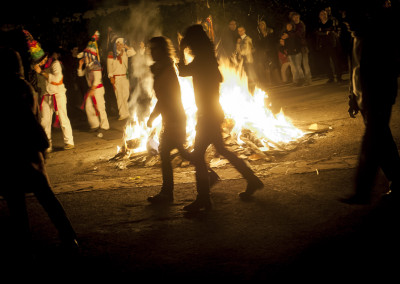Women on Basque Carnival Festivities
info
Carnival is transgression, breach, rupture. We hide our identity, and we become someone else, we are transformed into something else. When disguised, we erase our everyday identity, and for a while, we play to be something else. We leave being ordinary individuals chained to the everyday life and become costumes of our dream and nightmares. The boring honesty disappears and in this anonymity we have the opportunity to be provocative, insolent and transgressive.
From Orense to Dalmatia and from Sardinia to Navarre is common the habit to disguise as a violent bear, colorful harlequin, noisy cowbell player or gorgeous dancers. And as women. Women, or at least their image, repeatedly appears in several carnivals. Men love to disguise as women; as angelical bride lady or obscene prostitute, transvestism is pleasant to men. Wearing a dress, wigs, painted lips and a pair of breasts, carnivals offers a great opportunity, without questioning their masculinity, to put women’s clothing. Furthermore, it might also be useful to assert masculinity. Yes, the image of the woman is common in the Carnival, whenever is the male who shape it.
Another issue is if women can take part in a costume party. We formulate transgression as the costume party was an exclusively for men. The ritual we sell as liberator, is used to reinforce the dominant position men’s have in our society. Pace of work can be broken in carnival season; Needless to say with seriousness, order, silence, gentleness… But looks like gender segregation is untouchable. During the carnival, we show that we are able to limit the breach, always with genre limits.
Freedom in carnival season is like the ancient Athenian democracy. On the Greek system, which was politically pioneer, all citizens had the right to participate in government decision-making. But only free men were considered as citizen, women and slaves had no card to that draw. And there is where we put now the trap. In some carnivals that want to proclaim the pedigree of the tradition, in the middle of the mess, in the name rituals, symbols, or tradition, some rules are invented, rules in order to to continue with gender discrimination. In that period we present as a non-rule era.
Dressing up is a transformative action. The spell doesn’t last long, just a few hours, a few days at most, until the trail of drunkenness disappears. But in that period of magic, the transformation of our shell offers us a new identity. We carry a new personality that has nothing to do with what has been ours until then and we play the costume as if we had never been anything else. The costume doesn’t have much to do with us, it’s not us, and apart from the size, it doesn’t look like us either.
It is absurd and reactionary having genre limitations to wear some costumes. What should be hard to understand in any context, it becomes absurd in carnival period. The City Council organizing a carnival parade is the best strategy to try to kill the carnival. Another one is the implementation of rules to disguise. Fortunately the will to become the carnival into an offense, offered women access to most of the carnival festivities.
Oier Araolaza (Anthropologist and journalist).
















